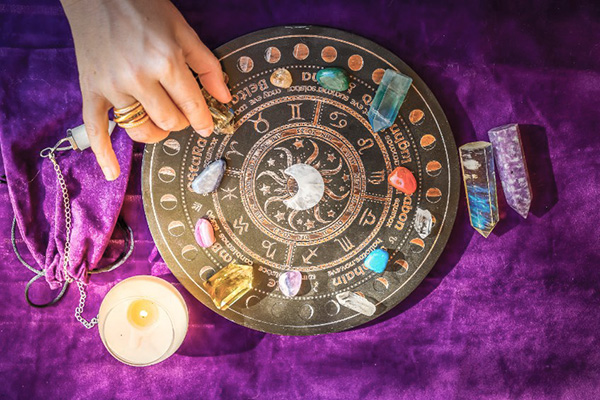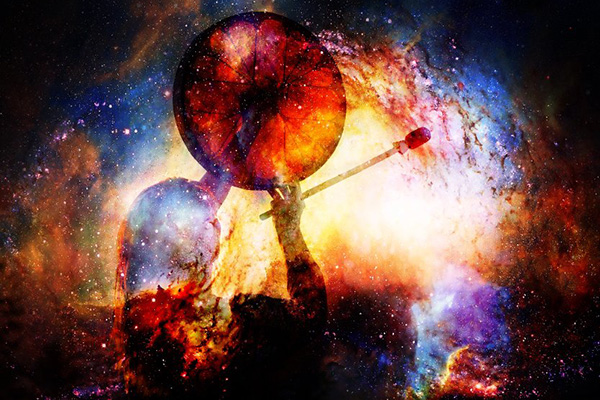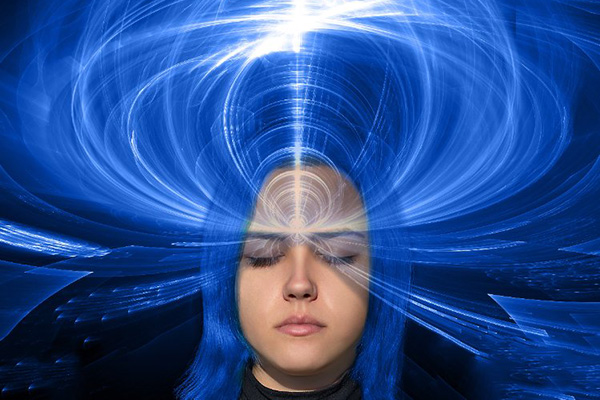spiritual traditions
A Rainbow Of Crystals
 Few metaphysical tools are as universal as crystals and stones, which are used in cultures all over the world. The color of each stone also carries certain traditional meanings and universal symbolism.
Few metaphysical tools are as universal as crystals and stones, which are used in cultures all over the world. The color of each stone also carries certain traditional meanings and universal symbolism.
Red is a powerful shade with associations of love, war, fire, sex appeal, and blood. It is also a masculine color. Use stones such as ruby, red jasper, or garnet when you need extra protection or energy.
Orange is also linked to warmth and is thought to increase appetite and vitality. Try orange gems for self-esteem and creativity. Carnelian and calcite are both orange shades.
Yellow is almost always a symbol of happiness, optimism, and intellect. If you need clarity and relief from burnout, pick up a yellow stone like amber, citrine or lemon quartz.
Green, not surprisingly, is the color of nature, growth, and rebirth. It is perhaps the best all-purpose magical color. It can also be used to attract abundance or wealth. There are many popular green stones, among them jade, agate, and peridot.
Blue, the most calming color, was revered in many ancient cultures. Today it is connected to artistic and psychic talents. Use stones such as lapis lazuli or aventurine if you’re in need of some inner peace, or sleep.
Purple was once associated with royalty; it is now a color of spiritual fulfillment and magic. Use it to stimulate your creativity or remove impediments. Amethyst is a popular and widely available purple stone.
Modern Misunderstanding Of The Occult
 I recently had an interesting conversation with a casual acquaintance about spirituality and the occult. She is new to metaphysics and mysticism, but since these topics are of great interest and intrigue to me, I needed no convincing to dive into it with her.
I recently had an interesting conversation with a casual acquaintance about spirituality and the occult. She is new to metaphysics and mysticism, but since these topics are of great interest and intrigue to me, I needed no convincing to dive into it with her.
It soon became obvious that she had some misunderstandings, and even a few misgivings regarding these matters. For example, she believes a ‘spiritual person’ is someone who engages in some form of religion or spiritual practice, such as meditation or prayer. She also believes spirituality is the exclusive domain of humans, as animals do not practice any religion or spirituality – they merely exist in nature.
Many people confuse ‘being religious’ with ‘being spiritual’ – one does not necessarily imply the other. Living a spiritually aware or conscious life simply means ‘living in the truth’ of who you are – a spirit being in human form. One can be religious, but it is not a prerequisite to living your true spiritual identity.
I also explained to her that the creatures of this earth may appear to be ‘soulless,’ but all living, sentient beings, as well as nature at large, are all expression of Spirit, God, Source, Universe, the Divine. How the animals operate and survive in this world is what is inherently true of the inner being of who they truly are. The entire universe is an expression of its sacred origins. In fact, in my opinion animals live with much greater alignment to higher consciousness than most modern humans do!
It took her some time to evaluate these concepts, but she did eventually come to a conclusion that there must be some truth to it. However, the real fun began when I mentioned my life-long interest in the occult. She vehemently protested that everything relating to the occult is “evil and demonic.” I asked her what facts or personal experience she based this opinion on, but her only justification was that this is “what most people believe.”
Prophets, Or Time Travelers?
 Could some of the famous prophets, such as Nostradamus, or the prophets of the King James Version of the Bible, or the prophet Mohammad, actually have been time travelers?
Could some of the famous prophets, such as Nostradamus, or the prophets of the King James Version of the Bible, or the prophet Mohammad, actually have been time travelers?
And is it merely coincidence that the Oracle of Delphi used a brass seat for visions of the future? As did Nostradamus, the 16th Century French poet and visionary. Nostradamus writes, “I will be seated at night, in my secret study. Alone sitting upon a stool of brass, a flame shall leap forth from the solitude, granting that which is not to be believed in vain.”
And, in the 1895 HG Wells fiction novel, The Time Machine, the protagonist of the story uses a black and polished brass time machine to gain mechanical control over time. Is there something about sitting on brass that allows one to see into the future? Or, could they possibly be talking about a brass seat on a sort of vehicle?
There is a mystic figure called Khidr in Islamic exegesis. Khidr is said to have met Islamic figures and prophets at different times and places. It is difficult for scholars to understand how that could be – unless Khidr was a time traveler or an immortal being. Khidr was said to have met with Moses, Abu Zur’a al-Razi and Elijah. It is also believed that Elijah and Khidr may be the same person.
The scriptures say that Elijah did not die that he ascended into heaven (time travel) and would return as one of the two witnesses of the Great Tribulation period that would precede the Second Coming of Christ.
Enoch, from the Biblical scriptures is said to have taken many trips to heaven to meet the pre-existent Son of Man, whom Enoch prophesied would judge the souls of all men. Is this too, another instance of time travel? Interestingly, the book of Enoch was omitted from the King James Version of the Bible.
In several instances of supposed time travel a “storm” or a “ball of fire” or even a “chariot of fire” is mentioned. As in the book of Ezekiel, when he has a vision of the future, he mentions a whirl wind coming out of the north, a great cloud with raging fire, engulfing itself – this being the first of the prophet’s visions.
The Good Old Days Of Tribal Service
 Someone once asked me the question: why do you do what you do? Most psychics might say that they do it because they love helping people. I gave it careful some thought and realized my answer would be the same, but under different terms. That isn’t to say that I don’t love helping others, but there would be different boundaries, if I was free to choose.
Someone once asked me the question: why do you do what you do? Most psychics might say that they do it because they love helping people. I gave it careful some thought and realized my answer would be the same, but under different terms. That isn’t to say that I don’t love helping others, but there would be different boundaries, if I was free to choose.
I work in the New Age ways, as well as in the indigenous traditions, and I pride myself on the knowledge I have gained in order to truly blend the East with the West. If I had a choice, I would work in the indigenous tradition of my ancestors, especially regarding how one is remunerated for your service.
In the indigenous way, each village had a spiritual person that they called by various names, including Medicine Man, Shaman, Healer, Guru, Oracle, Soothsayer. It was the way in those cultures to take care of the spiritual leaders of the tribe, in terms of their material needs. They shared equally whatever they had with their spiritual leader.
As a result, the spiritual leader didn’t have to focus any of his time on meeting his material needs, such as keeping a roof over his head, or thinking in terms of where his next meal would come from. Instead, he could devote all of his time and energy to spiritual matters.
His payment for his gifts didn’t include whatever the tribe used for money or barter, or if it did, it was not thought of in the same context. In other words, anyone in his tribe could come to him at anytime, with any kind of spiritual issue, and he could address it however he deemed necessary, according to his own sense of direction and spirit guidance. He didn’t have to consider time, energy, and money. He didn’t have to require payment in terms of the time he spent or what was required, because he was so esteemed by his people that they took care of his worldly needs, so he could devote himself to their spiritual needs completely. What a concept! Right?
The Deeper Meaning Of Color Stereotypes
 Have you ever heard the expression someone “talks a blue streak?” It refers to a person who talks rapidly and non-stop. But why use the adjective blue? I suspect it may originate from the metaphysical tradition of the color blue being associated with speaking one’s truth (throat chakra) and creative expression. People who gravitate towards this color are often creatives or performers, such as designers, fine artists, singers, dancers, and so on.
Have you ever heard the expression someone “talks a blue streak?” It refers to a person who talks rapidly and non-stop. But why use the adjective blue? I suspect it may originate from the metaphysical tradition of the color blue being associated with speaking one’s truth (throat chakra) and creative expression. People who gravitate towards this color are often creatives or performers, such as designers, fine artists, singers, dancers, and so on.
Communicating succinctly is the most powerful way we can make a connection with others beyond our subliminal energy connections with everyone around us. An over-abundance of words, however, translates into a lack of trust on the speaker’s part that she is not accepted by others, be it family members, coworkers, friends, or stranger she encounters along her life path. Speaking clearly and concisely is an art.
The color red also holds a fascination for me, as I perceive it to be a color that is so amazingly misunderstood. Red is generally interpreted as the color of anger, such as “I was so mad, I was seeing red.” Red is also used to denote danger in road signs and red cars are said to be associated with speed and aggressive driving.
But the color red also has many positive symbolic meanings in different cultures, including about passion, excitement, love, vigor, health, life and even spiritual zeal.
Another brilliant color that is often misrepresented is black. Once again, it is generally seen as a color related to depression, sadness, gloom, negativity and evil. In my view black stands out as a harmonious hue. If we see it in a positive light, black can be considered as a sharply defined, elegant color. It is symbolic of power, mystery, and sophistication. No one can deny the glamour of showing up to a dinner party in a smart little black dress or a tailored black tuxedo.

